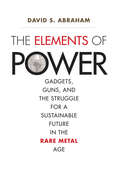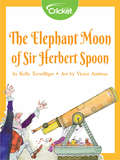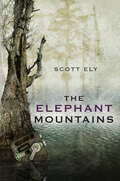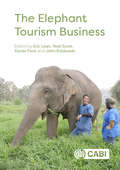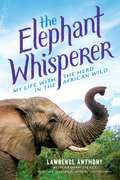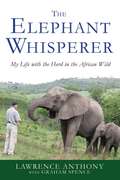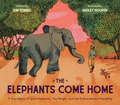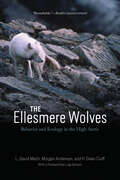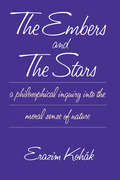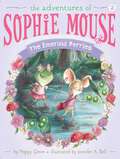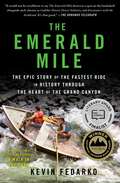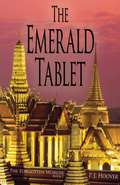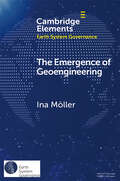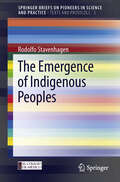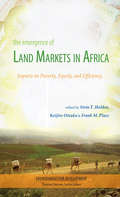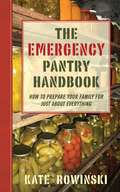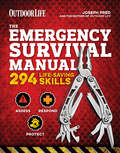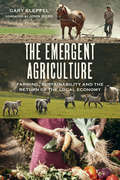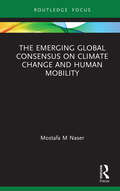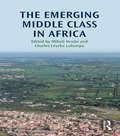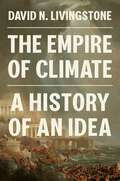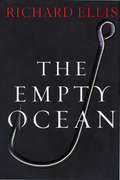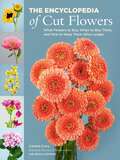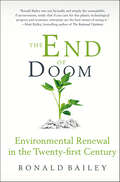- Table View
- List View
The Elements of Power
by David S. AbrahamOur future hinges on a set of elements that few of us have even heard of. In this surprising and revealing book, David S. Abraham unveils what rare metals are and why our electronic gadgets, the most powerful armies, and indeed the fate of our planet depend on them. These metals have become the building blocks of modern society; their properties are now essential for nearly all our electronic, military, and "green" technologies. But their growing use is not without environmental, economic, and geopolitical consequences. Abraham traces these elements' hidden paths from mines to our living rooms, from the remote hills of China to the frozen Gulf of Finland, providing vivid accounts of those who produce, trade, and rely on rare metals. He argues that these materials are increasingly playing a significant role in global affairs, conferring strength to countries and companies that can ensure sustainable supplies. Just as oil, iron, and bronze revolutionized previous eras, so too will these metals. The challenges this book reveals, and the plans it proposes, make it essential reading for our rare metal age.
The Elephant Moon of Sir Herbert Spoon
by Kelly TerwilligerSir Herbert Spoon alerts Cecil Spout, his butler, that he has spotted an elephant on the moon through his telescope.
The Elephant Mountains
by Scott ElyAn unprecedented series of hurricanes has swollen the Mississippi River to unheard-of levels and is threatening to put New Orleans and most of the low-lying areas of the South under water. Fifteen-year-old Stephen is spending the summer with his father near a small town north of Lake Pontchartrain when another powerful hurricane arrives and the levees on the Mississippi River completely fail. In the anarchy and chaos that results, Stephen's father is killed, and the boy is left to fend for himself. Stephen soon encounters Angela, a college student whose parents have also been killed. Navigating the labyrinth of flooded fields and towns in an airboat, the two set out in search of Stephen's mother and higher ground.
The Elephant Tourism Business
by Eric Laws Anja Pabel Rebecca Winkler Clive Phillips Eric Brymer Andrew McLean Professor Noel Scott Melville Saayman Daniel Turner Professor Xavier Font Mucha Mkono Ann Suwaree Ashton Liv Baker Sumanth Bindumadhav Sarah Blaine Naphawan Chantradoan Saranphat Chotmanakul Qingming Cui Susanna Curtin Charlotte Day Nilakshi Galahitiyawe Vivek Gurusamy Nicole Hausler Jeffrey Dale Hobbs Claire Jenkinson Professor John Koldowski Naut Kusters Shilpa Mahbubani Somyot Ongkhluap Piengpen Na Pattalung Kannapa Pongponrat Bongkosh Rittichainuwat John Edward Roberts Andrea Saayman Jan Schmidt-Burbach Alokparna Sengupta Vinathe Sharma-Brymer Ramona Strödecke Daminda Sumanapala Marjorie Van Strein Isabelle Wolf Honggang XuElephant tourism is a growing activity in many countries across Asia and Africa and is popular with tourists from all parts of the world. Elephant tourism has grown rapidly, providing the only viable way for elephants and their owners to survive since the banning of logging. Old logging camps have been developed into sanctuaries for some elephants, but many other camps were established as entertainment centres, resulting in serious welfare issues for the elephants and their mahouts. The profits from elephant tourism in Asia have encouraged African operators to follow a similar business model. This book draws attention to the need for a comprehensive and rigorous focus on local solutions to improve the welfare of captive elephants, their mahouts and local residents, and to enhance tourists' experiences of elephant tourism. It achieves this by: - Critically reviewing recent research into elephant tourism. - Providing contemporary analytical case studies of elephant tourism policy and practice. The Elephant Tourism Business will contribute to a better understanding of how elephant tourism is organised, regulated and promoted, both in elephant areas and tourist origin countries. It identifies priorities for future research into elephant tourism and provides a unique, authoritative resource for researchers, elephant managers and administrators, and tourism managers. The book will be of interest to academics and practitioners with backgrounds in conservation, the environment, tourism and veterinary sciences, and will appeal to tourists keen to experience elephants in person.
The Elephant Whisperer (Young Readers Adaptation): My Life with the Herd in the African Wild
by Thea Feldman Lawrence Anthony Graham SpenceWhen Lawrence Anthony was asked to accept a rogue herd of elephants in his reserve in South Africa, it was the last chance for these elephants. If Anthony didn’t take them, they would be shot. But he had no experience with elephants at all. What was he to do?Take them on, of course!What follows is an exciting and heartwarming series of adventures, in which Anthony learns about elephants and becomes part of their family. Full of both triumph and tragedy, this fascinating account of living with the majestic elephant is unforgettable.
The Elephant Whisperer: My Life With the Herd in the African Wild
by Lawrence Anthony Graham SpenceLawrence Anthony devoted his life to animal conservation, protecting the world's endangered species. Then he was asked to accept a herd of "rogue" wild elephants on his Thula Thula game reserve in Zululand. His common sense told him to refuse, but he was the herd's last chance of survival: they would be killed if he wouldn't take them. In order to save their lives, Anthony took them in. In the years that followed he became a part of their family. And as he battled to create a bond with the elephants, he came to realize that they had a great deal to teach him about life, loyalty, and freedom. The Elephant Whispereris a heartwarming, exciting, funny, and sometimes sad memoir of Anthony's experiences with these huge yet sympathetic creatures. Set against the background of life on an African game reserve, with unforgettable characters and exotic wildlife, Anthony's unrelenting efforts at animal protection and his remarkable connection with nature will inspire animal lovers and adventurous souls everywhere.
The Elephants Come Home: A True Story of Seven Elephants, Two People, and One Extraordinary Friendship
by Kim TomsicThe amazing true story of a herd of elephants, the man who saved them, and the miracle of love that brought them home.One day in 1999, Lawrence Anthony and Françoise Malby hear that a herd of wild African elephants need a new home. They welcome the elephants to their wildlife sanctuary—Thula Thula—with open arms. But the elephants are much less sure they want to stay. How will Lawrence prove to them that they are safe and loved? What follows is a gorgeously illustrated real-life story of a friendship . . . and the story of the miraculous way that love given freely will return—greater and more wonderful than it began.• TOUCHING ANIMAL FRIENDSHIPS: Owen and Mzee, Tarra and Bella, Rescue and Jessica . . . touching true stories of the emotional bonds possible between species are charming, and speak to the limitlessness of love.• ELEPHANT APPEAL: Elephants are one of the most fascinating and charming wild animals in all of nature. This heartwarming true story will intrigue and inspire children, and turn even the most reluctant readers into elephant enthusiasts.• CONSERVATION THEME: This book tells the true story of caring for one of the world's most beloved endangered animals: the African elephant. This book is a great, upbeat jumping-off point for discussions of the importance of preserving endangered species and their environments.• ENGAGING NONFICTION: There's no better way to get readers hooked on factual books than to offer them real-life stories with heart and meaning.• STRONG CURRICULUM CONNECTIONS: The Next Generation Science Standards (NGSS) emphasize learning about animal habitats/biomes in K–2 curriculums, while later grades address topics like conservation and endangered species. With a depth of research and an engaging, highly visual narrative, this book is an excellent resource for librarians and primary school educators.Perfect for:• Kindergarten and elementary school teachers• Parents and grandparents• Librarians• Lovers of animals, wildlife, and the natural world• Zoo and natural history museumgoers
The Ellesmere Wolves: Behavior and Ecology in the High Arctic
by L. David Mech Morgan Anderson H. Dean CluffIn a fascinating story of discovery and science, we meet a remote population of wolves unafraid of humans. For parts of twenty-four summers, wolf biologist L. David Mech lived with a group of wolves on Ellesmere Island, some six hundred miles from the North Pole. Elsewhere, most wolves flee from even the scent of humans, but these animals, evolving relatively free from human persecution, are unafraid. Having already spent twenty-eight years studying other populations of wolves more remotely by aircraft, snow-tracking, live-trapping, and radio-tracking, Mech was primed to join their activities up close and record their interactions with each other. This book tells the remarkable story of what Mech—and the researchers who followed him—have learned while living among the wolves. The Ellesmere wolves were so unconcerned with Mech’s presence that they allowed him to camp near their den and to sit on his all-terrain vehicle as he observed them, watching packs as large as seven adults and six pups go about their normal activities. In these extraordinarily close quarters, a pup untying his bootlace or an adult sniffing his gloved hand was just part of daily life. Mech accompanied the wolves on their travels and watched as they hunted muskoxen and arctic hares. By achieving the same kind of intimacy with his wild hosts’ every action that we might experience living with domesticated dogs, Mech gained new insights into common but rarely studied behaviors like pup feeding, food caching, howling, and scent-marking. After Mech’s time at Ellesmere ended, his coauthors and fellow wolf researchers Morgan Anderson and H. Dean Cluff spent parts of four summers studying the wolves via radio collars, further illuminating the creatures’ movements and ecology. This book synthesizes their findings, offering both a compelling scientific overview of the animals’ behavior—from hunting to living in packs to rearing pups—and a tale of adventure and survival in the Arctic.
The Embers and the Stars: A Philosophical Inquiry into the Moral Sense of Nature
by Erazim Kohák"It is hard to put this profound book into a category. Despite the author's criticisms of Thoreau, it is more like Walden than any other book I have read. . . . The book makes great strides toward bringing the best insights from medieval philosophy and from contemporary environmental ethics together. Anyone interested in both of these areas must read this book."—Daniel A. Dombrowski, The Thomist "Those who share Kohák's concern to understand nature as other than a mere resource or matter in motion will find his temporally oriented interpretation of nature instructive. It is here in particular that Kohák turns moments of experience to account philosophically, turning what we habitually overlook or avoid into an opportunity and basis for self-knowledge. This is an impassioned attempt to see the vital order of nature and the moral order of our humanity as one."—Ethics
The Emerald Berries (The Adventures of Sophie Mouse #2)
by Poppy GreenIn this second book of The Adventures of Sophie Mouse, Sophie and her friend Hattie Frog go on a daring adventure through the woods in search of some special art supplies!In the second book in The Adventures of Sophie Mouse, Sophie learns about some special emerald berries that will make the most perfect color for a painting she wants to do! But the seamstress who’s using the berries tells Sophie that they can only be found in one part of the forest: Weedsnag Way. Though that’s far from home, and a little scary, Sophie convinces her best friend, Hattie Frog, that they will be fine. But all is not quite fine, and the girls get lost along the way! Thanks to the help of a squirrel who disappeared from Pine Needle Grove years ago, Sophie and Hattie find the emerald berries…and their way home! With easy-to-read language and illustrations on almost every page, the Adventures of Sophie Mouse chapter books are perfect for beginning readers.
The Emerald Horizon: The History of Nature in Iowa
by Cornelia F. MutelBeginning with the geological forces that shaped the land, Mutel traces the evolution of Iowa's prairies and woodlands to the present time. She emphasizes the dramatic impact of Euro-American settlement and shows how farming and logging have destroyed fragile prairie and forest abitats. She discusses the potential of restoration and provides information for those who wish to launch restoration programs. The issues prominent in Iowa mirror those to be encountered in other prairie states.
The Emerald Mile: The Epic Story of the Fastest Ride in History Through the Heart of the Grand Canyon
by Kevin FedarkoFrom one of Outside magazine&’s &“Literary All-Stars&” comes the thrilling true tale of the fastest boat ride ever through the Grand Canyon, atop the legendary Colorado River flood of 1983.In the spring of 1983, massive flooding along the length of the Colorado River confronted a team of engineers at the Glen Canyon Dam with an unprecedented emergency that may have resulted in the most catastrophic dam failure in history. In the midst of this crisis, the decision to launch a small wooden dory named &“The Emerald Mile&” at the head of the Grand Canyon, just fifteen miles downstream from the Glen Canyon Dam, seemed not just odd, but downright suicidal. The Emerald Mile, at one time slated to be destroyed, was rescued and brought back to life by Kenton Grua, the man at the oars, who intended to use this flood as a kind of hydraulic sling-shot. The goal was to nail the all-time record for the fastest boat ever propelled—by oar, by motor, or by the grace of God himself—through the heart of the Grand Canyon atop the Colorado River from Lee&’s Ferry to Lake Mead. Did he survive? Just barely. Now, this remarkable, epic feat unfolds here, in The Emerald Mile.
The Emerald Tablet (The Forgotten Worlds #1)
by P. J. HooverBenjamin and his best friend Andy love being different from the other kids. They like being able to read each others mind and use their telekinesis to play tricks. In fact, they are getting set to spend their entire summer doing just that when Benjamin's mirror starts talking.
The Emergence of Geoengineering: How Knowledge Networks Form Governance Objects (Elements in Earth System Governance)
by Ina MöllerFor many years, suggestions to 'geoengineer' the climate occupied a marginal role in climate change science and politics. Today, visions of massive carbon drawdown and sunlight reflection have become reasonable additions to conventional mitigation and adaptation. Why did researchers start engaging with ideas that were, for a long time, considered highly controversial? And how did some of these ideas come to be perceived worthy of research funding and in need of international governance? This Element provides an analysis of the recent history and evolution of geoengineering as a governance object. It explains how geoengineering evolved from a thought shared by a small network into a governance object that is likely to shape the future of climate politics. In the process, it generates a theory on the earliest phase of the policy cycle and sheds light on the question why we govern the things we govern in the first place.
The Emergence of Indigenous Peoples
by Rodolfo StavenhagenThis is the second part of a trilogy published in the Springer Briefs on Pioneers in Science and Practice on the occasion of the 80th birthday of Rodolfo Stavenhagen, a distinguished Mexican sociologist and professor emeritus of El Colegio de Mexico. Rodolfo Stavenhagen wrote this collection of six essays on The Emergence of Indigenous Peoples between 1965 and 2009. These widely discussed classic texts address: Classes, Colonialism and Acculturation (1965); Indigenous Peoples: An Introduction (2009); The Return of the Native: The Indigenous Challenge in Latin America (2002); Indigenous Peoples in Comparative Perspective (2004); Mexico's Unfinished Symphony: The Zapatista Movement (2000); and Struggle and Resistance: Mexico's Indians in Transition (2006). This volume discusses the emergence of indigenous peoples as new social and political actors at the national and international level. These texts deal with human rights, especially during the years he the author served as United Nations special rapporteur on the rights of indigenous peoples.
The Emergence of Land Markets in Africa: Impacts on Poverty, Equity, and Efficiency (Environment for Development)
by Keijiro Otsuka Stein T. Holden Frank M. PlaceThis book is the first systematic attempt to address emerging land markets and their implications for poverty, equity, and efficiency across a number of African countries. The high incidence of poverty and the need for increased agricultural productivity remain acute in rural areas of sub-Saharan Africa, where a lack of secure land rights and a growing scarcity of land relative to the size of the population are becoming increasingly critical issues. Indeed, land issues in the region are high on the international policy agenda. Yet our knowledge about land tenure security and other rural factor markets (such as labor, oxen, manure, purchased inputs, and credit) is far from adequate to formulate sensible policies. The case studies in the book show that, while land markets and especially informal markets have been rapidly emerging in densely populated parts of Africa - and have generally been to the benefit of the poor--their functions remain imperfect. This is due to policy-induced tenure insecurity and the fragmentation of agricultural land. Applying rigorous quantitative analyses, the book provides a basis for taking into account the role of land markets in national land policies. All too often, the authors argue, land policies have been extreme, either prohibiting all land transactions or giving unrestricted freehold rights to a small elite at the expense of the poor. From the long experience in Asia, it is known that such policies are detrimental to both production efficiency and equity of land use. The authors argue that future policies in Africa should work with the markets. Regulations should be imposed only with careful testing that they are having the intended effects. The Emergence of Land Markets in Africa is a resource for teaching in developed and developing countries, as it provides both comprehensive reviews of the literature and detailed case studies. It is intended to facilitate the dialogue between researchers and policymakers, as well as inspire researchers to go further in their investigations and build an even stronger basis for good policies. The Emergence of Land Markets in Africa is the first publication in the new Environment for Development (EfD) book series. EfD books focus on research and applications in environmental and natural resource economics as they are relevant to poverty reduction and environmental problems in developing countries. The EfD book series is part of the EfD initiative. (www.environmentfordevelopment.org)
The Emergency Pantry Handbook: How to Prepare Your Family for Just about Everything
by Kate Rowinski Jim RowinskiIn today’s world, anything can happen—medical emergencies, power outages, natural disasters. In less time than it takes to sign off on an insurance form, the world as we know it can be brought to a standstill. There can be no question: It’s best to be prepared. The Emergency Pantry Handbook by cooking expert and readiness enthusiast Kate Rowinski offers tips, techniques, and advice on how to keep your family safe, well-fed, and fully supplied in the event of any crisis. With simple instructions, Rowinski demonstrates how to create an emergency strategy; how to protect your house, documents, and keepsakes; and how to prepare for specific disasters. Offering a unique twist on preparation handbooks, Rowinski focuses on food storage and cooking—put simply, how to plan nutritional emergency meals and avoid “making due” on canned meats and chocolate bars. The Emergency Pantry Handbook details:· Storage techniques · Personalizing your food plan · Stockpiling, shelf life, and rotation · Pickling, canning, sprouting, and drying · Making delicious dinners out of your storage pantry Whether a disaster lasts for twenty-four hours or twenty-four weeks, The Emergency Pantry Handbook is the ultimate guide to keeping your family eating healthily and maintaining proper nutrition, even in the worst of circumstances.
The Emergency Survival Manual: 294 Life-Saving Skills (Outdoor Life)
by The Editors of Outdoor Life Joseph PredFrom break-ins to basement flooding to broken bones, this guide has everything you need to be prepared for any emergency that comes your way.Who’s better suited to write a book about handling emergencies than an Emergency and Risk Management Consultant and the CEO of Mutual Aid Response Services (MARS)? Joseph Pred is the go-to-guy for assessing and handling emergencies. When you combine his knowledge with that of the experts at Outdoor Life magazine, what do you get? An epic book filled with lifesaving skills. This book also covers what to do before the first responders arrive…or if they never do.Basic Tools & Skills: Everything you need to know to assess and start handling an emergency. From stocking a first aid kit and treating burns, cuts and broken bones, to protecting yourself when using pepper spray and performing CPR.Home and Family Safety: Protect your house and keep you and your family safe. Learn how to deal with a lost child, handle house fires, public transit scares, car accidents, and help a sick or hurt pet.Community Safety: All the ways to help your neighbors and keep your community safe. From what to do if you see a house being broken into and dealing with school tragedies, to coping with a major natural disaster and handling a toxic spill—and everything in between.When disaster strikes you want to be ready, and you can be with the Emergency Survival Manual.
The Emergent Agriculture
by Gary Kleppel John IkerdLong embraced by corporations who are driven only by the desire for profit, industrial agriculture wastes precious resources and spews millions of tons of greenhouse gases into the atmosphere each year, exacerbating climate change and threatening the very earth and water on which we depend. However, this dominant system, from which Americans obtain most of their food, is being slowly supplanted by a new paradigm.The Emergent Agriculture is a collection of fourteen thematic essays on sustainability viewed through the lens of farming. Arguing that industrial food production is incompatible with the realities of nature, science, and ethics, this lyrical narrative makes the case for a locally based food system which is: Stable in the face of economic uncertainty Resilient in the face of environmental variability Grounded in stewardship of the land, on attaching value to food and the craft involved in producing it, and on respecting the dignity of farmers, consumer,s and livestockA revolution in food production is underway. Written from the vantage point of an ecologist who is also a farmer, The Emergent Agriculture is essential reading for anyone interested in food security and the potential for growing local economies. Food for thought about the future of food.Gary Kleppel is a professor of biology at the SUNY Albany, where he focuses on sustainable agriculture, conservation-based grazing, and the ecology of human-dominated landscapes. He and his wife Pam are owners of Longfield Farm, where they produce grass-fed lamb, wool, free range chickens and eggs, and artisanal breads.
The Emerging Global Consensus on Climate Change and Human Mobility (Routledge Focus on Environment and Sustainability)
by Mostafa M NaserThis book examines whether a global consensus is emerging on climate change and human mobility and presents evidence of a slow-moving but dynamic, step-by-step process of international policy development on climate-related mobility. Naser reviews the range of solutions offered to address climate-related mobility problems, such as extending the 1951 UN Refugee Convention, adopting an additional protocol to the UNFCCC or creating a new international treaty to support those facing climate-related migration and displacement problems. He examines the accumulating stock of international policies and initiatives relevant to climate-related mobility using a framework of six policy areas: human rights, refugees, climate change, disaster risk reduction, migration,and sustainable development. He uses this framework to define and summarise the main UN actions and milestones on climate-related mobility. Despite the difficult context affecting the global community of worsening climate change impacts and human rights under threat, Naser asserts that the foundations of global consensus on climate-related mobility have been built, particularly in the last decade. This book will be of great relevance to students, scholars and policy-makers with an interest in the increasing interface between climate change and human mobility policy issues.
The Emerging Middle Class in Africa
by Mthuli Ncube Charles Leyeka LufumpaThe emergence of the African middle class as a driver of Africa’s economic growth stands out as an important milestone in Africa’s contemporary economic history. This growth, though uneven, is a source of hope for Africa, but also a signal to the rest of the world on the prospects for economic recovery and renewal, particularly because it has been steady despite the global downturn. The Emerging Middle Class in Africa analyses specific aspects of the lives of the middle class in Africa. It looks at how people become and remain in the middle class through a series of thematic chapters. It examines how behaviour changes in the process, in terms of consumption patterns and spending on health and education. A further dimension of this analysis is how class impacts on gender relations and whether women are able to reap the same benefits of social advancement available to men. Africa is a continent of such scale and diversity that experiences across countries vary widely. The book thus captures the common patterns across the continent. This text is primarily aimed at Africanist researchers, policy makers, development practitioners, and bilateral and multilateral institutions, as well as students of African studies, political science, political economy, development studies, and development economics.
The Empire of Climate: A History of an Idea
by David N. LivingstoneHow the specter of climate has been used to explain history since antiquityScientists, journalists, and politicians increasingly tell us that human impacts on climate constitute the single greatest threat facing our planet and may even bring about the extinction of our species. Yet behind these anxieties lies an older, much deeper fear about the power that climate exerts over us. The Empire of Climate traces the history of this idea and its pervasive influence over how we interpret world events and make sense of the human condition, from the rise and fall of ancient civilizations to the afflictions of the modern psyche.Taking readers from the time of Hippocrates to the unfolding crisis of global warming today, David Livingstone reveals how climate has been critically implicated in the politics of imperial control and race relations; been used to explain industrial development, market performance, and economic breakdown; and served as a bellwether for national character and cultural collapse. He examines how climate has been put forward as an explanation for warfare and civil conflict, and how it has been identified as a critical factor in bodily disorders and acute psychosis.A panoramic work of scholarship, The Empire of Climate maps the tangled histories of an idea that has haunted our collective imagination for centuries, shedding critical light on the notion that everything from the wealth of nations to the human mind itself is subject to climate&’s imperial rule.
The Empty Ocean: Plundering The World's Marine Life
by Richard EllisIn The Empty Ocean, acclaimed author and artist Richard Ellis tells the story of our continued plunder of life in the sea and weighs the chances for its recovery. Through fascinating portraits of a wide array of creatures, he introduces us to the many forms of sea life that humans have fished, hunted, and collected over the centuries, from charismatic whales and dolphins to the lowly menhaden, from sea turtles to cod, tuna, and coral. Rich in history, anecdote, and surprising fact, Richard Ellis's descriptions bring to life the natural history of the various species, the threats they face, and the losses they have suffered. Killing has occurred on a truly stunning scale, with extinction all too often the result, leaving a once-teeming ocean greatly depleted. But the author also finds instances of hope and resilience, of species that have begun to make remarkable comebacks when given the opportunity. Written with passion and grace, and illustrated with Richard Ellis's own drawings, The Empty Ocean brings to a wide audience a compelling view of the damage we have caused to life in the sea and what we can do about it. "
The Encyclopedia of Cut Flowers: What Flowers to Buy, When to Buy Them, and How to Keep Them Alive Longer
by Calvert CraryFrom Calvert Crary and Bruce Littlefield, The Encyclopedia of Cut Flowers is a comprehensive, gorgeously visual guide that answers every question you've ever had (and a few you didn't know to ask!) about buying, caring for, and prolonging the lives of more than 140 different varieties of commonly available cut flowers.The Encyclopedia of Cut Flowers dives deep into the world of fresh-cut flowers, featuring unique entries for 143 different varieties of commonly available cut flowers that readers can buy at their local grocery store or flower market. Each flower entry offers authoritative tips for conditioning methods (eg–cut flowers should never be put near fresh fruit because fruit produces ethylene gas which will shorten the flowers' life), as well as scientific and common names, best seasons for buying (eg—lilies in spring, dahlias in summer) and fascinating facts about each bloom. An introductory section offers basic tips for styling arrangements at home, and for keeping flowers hydrated and alive for as long as possible. By the time readers are done flipping through the pages of The Encyclopedia of Cut Flowers, which features more than 150 gorgeous color photographs of flowers, they'll be experts in the field!
The End of Doom: Environmental Renewal in the Twenty-first Century
by Ronald BaileyIn the past five decades there have been many, many forecasts of impending environmental doom. They have universally been proven wrong. Meanwhile, those who have bet on human resourcefulness have almost always been correct. In his widely praised book Ecoscam, Ronald Bailey strongly countered environmentalist alarmism, using facts to demonstrate just how wildly overstated many claims of impending ecological doom really were. Now, twenty years later, the Reason Magazine science correspondent is back to assess the future of humanity and the global biosphere. Bailey finds, contrary to popular belief, that many present ecological trends are quite positive. Including: Falling cancer incidence rates in the United States. The likelihood of a declining world population by mid-century. The abundant return of agricultural land to nature as the world reaches peak farmland. A proven link between increases in national wealth and reductions in air and water pollution Global warming is a problem, but the cost of clean energy could soon fall below that of fossil fuels.In The End of Doom, Bailey avoids polemics and offers a balanced, fact-based and ultimately hopeful perspective on our current environmental situation. Now isn't that a breath of fresh air?
